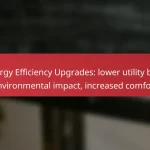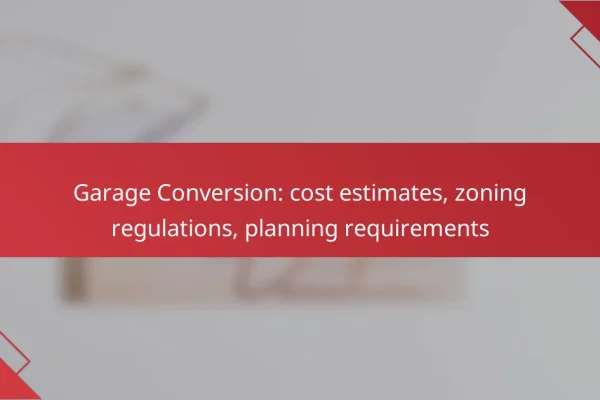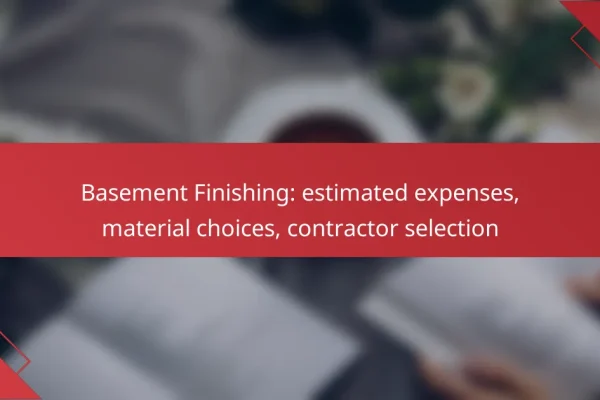What are the costs of home improvements in the UK?
The costs of home improvements in the UK can vary widely based on the type of project, materials used, and location. Generally, homeowners should budget for several thousand pounds for significant renovations, with costs influenced by labor and material prices in their area.
Average cost of kitchen renovations
The average cost of kitchen renovations in the UK typically ranges from £5,000 to £20,000, depending on the extent of the work. A simple facelift, such as repainting cabinets and updating fixtures, can be on the lower end, while a complete remodel with new appliances and layouts will push costs higher.
When planning a kitchen renovation, consider factors like the quality of materials, the complexity of the design, and whether you need to hire professionals for installation. It’s advisable to get multiple quotes from contractors to ensure competitive pricing.
Average cost of bathroom upgrades
Bathroom upgrades in the UK usually cost between £3,000 and £10,000. Basic updates, such as replacing fixtures and tiles, are more affordable, while full renovations that include plumbing changes and new layouts can be significantly more expensive.
To manage costs effectively, prioritize essential upgrades that improve functionality and aesthetics. Always check for any necessary permits or regulations, especially if plumbing work is involved, as this can impact your budget.
Average cost of garden landscaping
The cost of garden landscaping can vary from £1,000 to over £10,000, depending on the size of the garden and the complexity of the design. Simple landscaping, such as planting and mulching, will be less expensive than installing features like patios, ponds, or intricate garden designs.
When considering landscaping, think about long-term maintenance costs and choose plants and materials that suit your climate and lifestyle. Hiring a professional landscaper can help you achieve a cohesive design, but be sure to compare quotes and check their previous work.
How to budget for home improvements?
To budget for home improvements, start by estimating the total costs of your desired projects and comparing them to your available funds. This process involves careful planning and prioritization to ensure you achieve the best results without overspending.
Creating a home improvement budget
Begin by listing all potential projects, such as kitchen renovations, bathroom upgrades, or landscaping. For each project, research estimated costs, including materials and labor, to create a comprehensive budget. Aim for a budget that includes a contingency of around 10-20% to cover unexpected expenses.
Consider using a spreadsheet to track your budget, allowing you to easily adjust figures as needed. Break down larger projects into smaller tasks to better manage costs and timelines, ensuring you stay on track financially.
Prioritizing projects based on ROI
When prioritizing home improvement projects, focus on those that offer the highest return on investment (ROI). Generally, kitchen and bathroom remodels tend to yield significant returns, often recouping a substantial portion of their costs when you sell your home.
Evaluate each project based on its potential impact on your home’s value and your personal enjoyment. For instance, energy-efficient upgrades may lower utility bills and appeal to future buyers, making them a smart choice. Use online resources or consult local real estate agents to gauge which improvements are most valued in your area.
What are the logistics of home improvement projects?
The logistics of home improvement projects involve planning, coordinating resources, and managing timelines to ensure successful renovations. Key factors include scheduling, budgeting, and selecting the right contractors or materials to meet project goals.
Planning timelines for renovations
Establishing a timeline is crucial for any renovation project. Start by determining the scope of work and breaking it down into phases, such as design, permitting, and construction. A typical home improvement project can take anywhere from a few weeks to several months, depending on complexity.
Consider potential delays from weather, supply chain issues, or contractor availability. It’s wise to build in buffer time for unexpected challenges, aiming for a flexible schedule that allows adjustments as needed.
Hiring contractors in the UK
When hiring contractors in the UK, it’s essential to research and vet potential candidates thoroughly. Look for licensed professionals with good reviews, and consider asking for recommendations from friends or family. Obtain multiple quotes to compare costs and services offered.
Ensure that the contractor is familiar with local regulations and building codes, which can vary by region. It’s also advisable to check if they have insurance and warranties for their work to protect against future issues.
How to choose the right materials for home improvements?
Choosing the right materials for home improvements involves considering durability, cost, and suitability for your specific project. Evaluate your options based on these factors to ensure long-lasting and effective upgrades.
Comparing materials for durability
Durability is a critical factor when selecting materials for home improvements. For example, hardwood flooring typically lasts longer than laminate, while metal roofing outperforms asphalt shingles in longevity. Assess the expected lifespan of each material and consider local climate conditions that may affect durability.
Another aspect to consider is maintenance. Some materials, like vinyl siding, require less upkeep than wood, which may need regular painting or sealing. Prioritize materials that align with your willingness to maintain them over time.
Cost-effective options for home upgrades
Cost-effective materials can significantly reduce your home improvement budget without sacrificing quality. For instance, opting for engineered wood instead of solid wood can save you money while still providing a similar aesthetic. Additionally, consider using recycled materials, which can be both affordable and environmentally friendly.
When planning your upgrades, research local suppliers for competitive pricing and potential discounts on bulk purchases. Keep an eye out for sales or clearance items that can offer substantial savings on quality materials.
What are the common pitfalls in home improvement projects?
Common pitfalls in home improvement projects include overestimating DIY capabilities and ignoring local regulations and permits. These mistakes can lead to increased costs, delays, and even legal issues.
Overestimating DIY capabilities
Many homeowners believe they can handle complex renovations themselves, which often leads to subpar results. It’s essential to realistically assess your skills and the project’s demands before diving in.
For example, tasks like electrical work or plumbing require specialized knowledge and tools. If you’re unsure about your abilities, consider hiring a professional to avoid costly mistakes and ensure safety.
Ignoring local regulations and permits
Failing to check local regulations and obtain necessary permits can result in fines and the need to redo work. Each municipality has specific codes that govern construction and renovation projects.
Before starting any home improvement, research your area’s requirements. This may include obtaining permits for structural changes, electrical upgrades, or plumbing modifications. Taking this step can save you from future headaches and ensure your project complies with local laws.
How to find reliable contractors for home improvements?
To find reliable contractors for home improvements, start by seeking recommendations from friends, family, or neighbors who have recently completed similar projects. Additionally, verify their credentials, read reviews, and request quotes to ensure you select a trustworthy professional.
Top-rated contractors in London
In London, top-rated contractors often have a strong online presence and positive customer feedback. Look for professionals with experience in your specific type of home improvement, whether it’s renovations, extensions, or landscaping.
Consider checking platforms like Trustpilot or Checkatrade to find contractors with high ratings. A good contractor should also be registered with relevant trade organizations, which can provide an added layer of assurance regarding their qualifications.
Online platforms for contractor reviews
Online platforms for contractor reviews are essential tools for homeowners. Websites like Yelp, Angie’s List, and Houzz allow users to read firsthand experiences and ratings from previous clients, helping you gauge the reliability of potential contractors.
When using these platforms, pay attention to the number of reviews and the overall rating. A contractor with numerous positive reviews is generally a safer choice than one with only a few testimonials. Always look for detailed feedback that highlights both strengths and weaknesses to get a balanced view.
What financing options are available for home improvements?
Home improvement financing options include personal loans, home equity loans, and credit cards. Each option has different terms, interest rates, and repayment structures, making it essential to evaluate which fits your financial situation best.
Personal Loans
Personal loans are unsecured loans that can be used for various purposes, including home improvements. They typically have fixed interest rates and repayment terms ranging from two to seven years. Borrowers should compare rates from multiple lenders to find the most favorable terms.
One advantage of personal loans is that they do not require collateral, meaning your home is not at risk. However, interest rates can be higher than secured loans, so it’s crucial to assess your credit score and shop around for the best deal.
Home Equity Loans
Home equity loans allow homeowners to borrow against the equity they have built in their property. These loans usually offer lower interest rates compared to personal loans because they are secured by the home. Borrowers can receive a lump sum, which is then repaid over a fixed term.
While home equity loans can provide substantial funding for significant renovations, they do carry the risk of foreclosure if payments are missed. Homeowners should ensure they can comfortably manage the additional monthly payment before proceeding.
Credit Cards
Using credit cards for home improvements can be convenient, especially for smaller projects. Many credit cards offer promotional 0% APR periods, allowing you to finance improvements without interest for a limited time. However, after the promotional period, rates can increase significantly.
It’s essential to keep an eye on your spending and repayment timeline to avoid high-interest charges. For larger projects, relying solely on credit cards may not be advisable due to potential debt accumulation.















